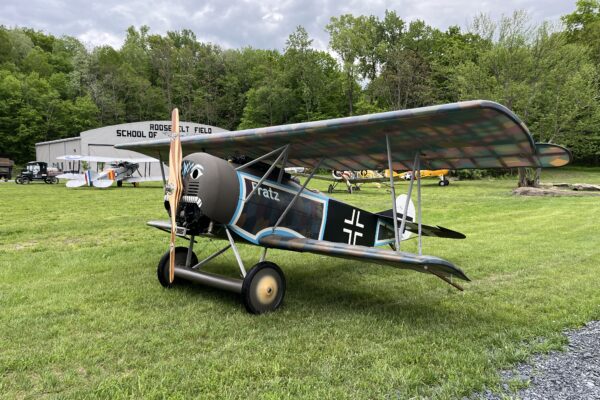
Fokker D.VI
- : Germany
- : 1917
- : Oberursel Ur. II
- 110
- 25 '
- 120 mph (192 km/hr)
- 1283 lbs (582 kg)
- : Active
- : Reproduction
Using the fuselage and empennage from the Fokker Dr. 1 and scaled-down wings from the D.VII, designer Reinhold Platz created a well-balanced fighter more than capable of withstanding the rigors of aerial combat. His strong cantilever wing design required no external bracing. The V.13 prototypes were readily accepted as the best rotary powered aircraft at the January 1918 fighter trials at Aldershof. By the time production began in March, the designation of V.13 was replaced by D.VI and the type was built with a supply of 110 hp. Oberursel engines.
The Oberursel (a copy of the French Le Rhone) was prone to mechanical issues brought on, in part, by the lack of castor oil lubricant. The production demands for the vaunted D.VII relegated the D.VI to just 59 built before being shut down altogether in August of 1918. Seven were sent to Austria for war service. The rest were sent to a handful of front-line squadrons such as Jagdstaffel 80b. The rest were sent to fighter schools for advanced training.
Our D.VI is finished with a printed lozenge camouflage fabric and embellished with the personal markings Jasta 80b ace; Ltn. Kurt Seit. As a Bavarian, Seit added the state colors of blue and white to the fuselage and tail, the nickname “Fratz”, and a menacing face to the cowling. Seit accumulated five victories while flying the D.VI and D.VII fighters before war’s end.
This faithful replica was constructed in Chicago by Charles Brady in 1998. It is powered by 145 hp. Warner radial engine and was flown by Brady for approximately 25 hours before selling it to the Old Rhinebeck Aerodrome in the Spring of 2024. True to form, the D.VI was quite maneuverable. With an experienced hand at the controls, it was a deadly opponent in a dogfight.
Click for more information about the Fokker D.VI
